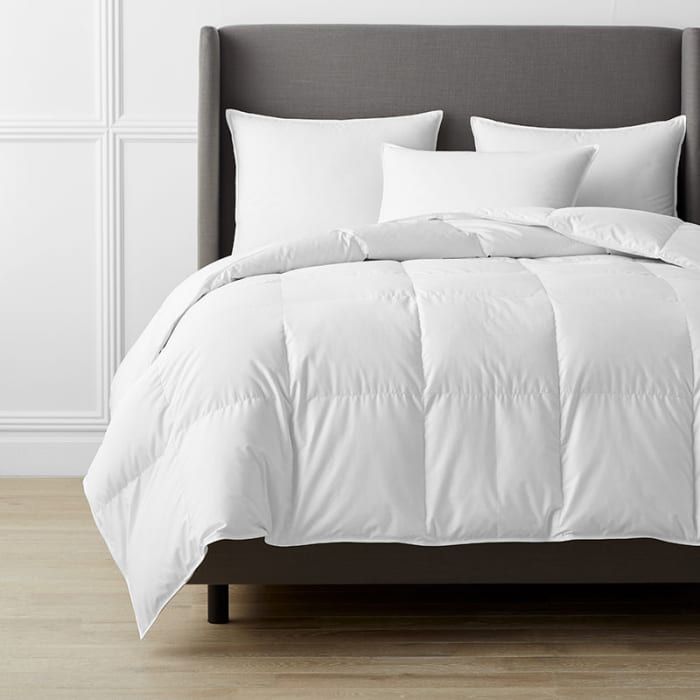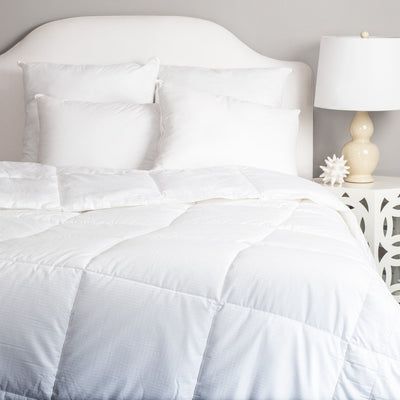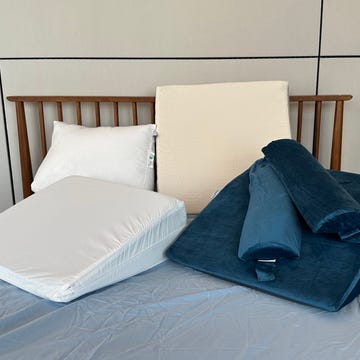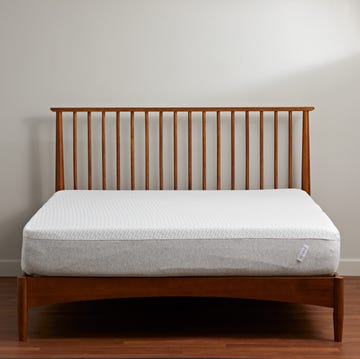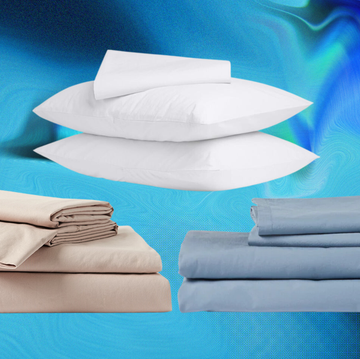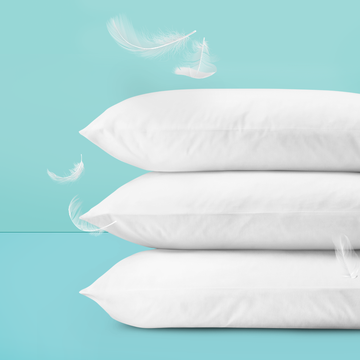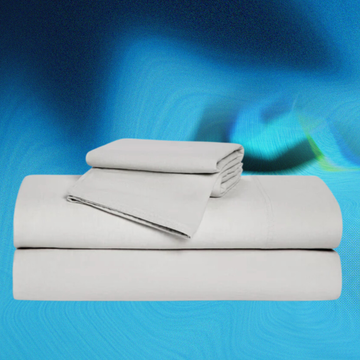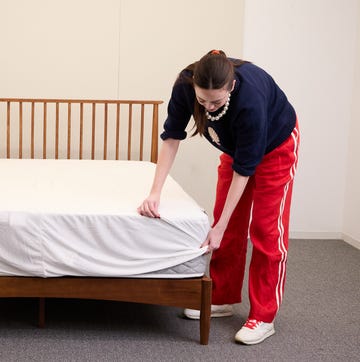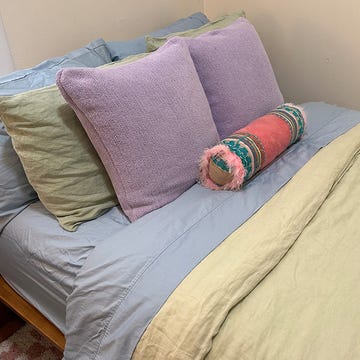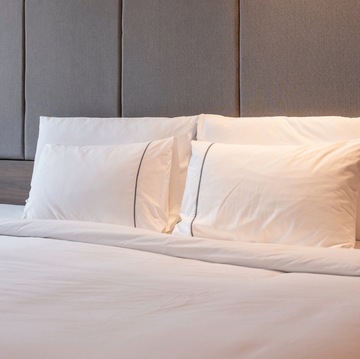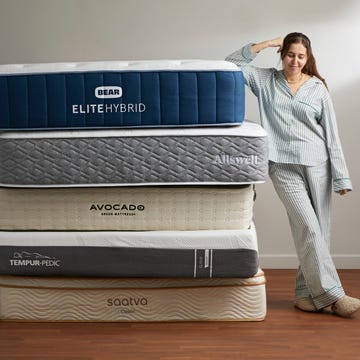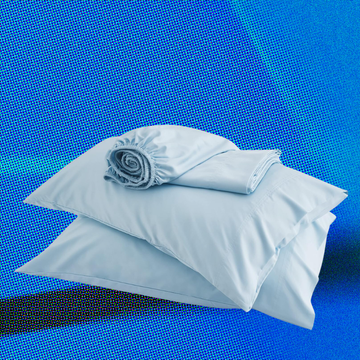The Best Comforters, Tested and Approved by Bedding Experts
We evaluated dozens of comforters to find the best ones for every type of sleeper.

We've been independently researching and testing products for over 120 years. If you buy through our links, we may earn a commission. Learn more about our review process.
It's no surprise that the right comforter can make or break a restful night's sleep. You'll want it to be warm without causing you to overheat, made with a comfy outer fabric that isn't rough or noisy and evenly filled so that its stuffing doesn't clump or poke through. With so many options for materials, warmth levels and prices, it can be tricky to find one that you know is worth the cost and will last.
Each year, bedding experts at the Good Housekeeping Institute evaluate dozens of comforters in the Textiles, Paper and Apparel Lab and in the homes of real sleep testers. We start off by thoroughly inspecting the construction for aspects like fill distribution, stitching quality, odor, fluffiness and more. At-home testers weigh in on aspects like comfort, temperature regulation, noise level and fill shifting, among others. In recent years, we've tested over 70 different comforters and reviewed more than 3,000 responses to related survey questions before making our recommendations.
Pros
Light and fluffy fill
Soft, quiet outer cover
GH textile experts use it in their own homes
Cons
Only one warmth level available
Fill: Polyester | Outer cover: Tencel lyocell | Construction: Stitched-through | Sizes: Twin/Twin XL, Full/Queen and King/California King
Buffy's comforter earns our top spot for being exceptionally soft and for its innovative construction that prevents the fill from clumping, shedding or creating cold spots. The down-alternative fill is one large web of fibers instead of individual fiber clusters, and its cover uses wavy stitching instead of squares to avoid compressing the layers, allowing for a puffy look and feel.
Compared to other comforters, this one also has some sustainable features: Its polyester fill is derived from plastic bottles, and it has a Global Recycling Standard (GRS) certification to back up this claim. The outer cover is Tencel lyocell, a material that's smooth, lightweight, responsibly sourced and temperature-regulating.
What testers say: GH textile experts use the Buffy in their own homes and the unbeatable comfort stood out most to our testers, who described it as feeling like sleeping on a cloud. "I've never slept under such a fluffy comforter," one said. Users noted that it felt comfortable for year-round use; one told us, "I didn't overheat, but it still felt substantial."
It also didn't make any crinkly noises, which is a common issue with comforters. Keep in mind that it's only available in one warmth level.
READ OUR FULL REVIEW: Buffy Cloud Comforter
Pros
Buttery soft cover
More than 28,000 Amazon reviews and a 4.7-star rating
Lightweight design
Cons
Synthetic fill and cover may be too warm for hot sleepers
Fill: Polyester | Outer cover: Polyester and spandex | Construction: Box stitch | Sizes: Twin, Twin XL, Full, Queen, Queen Plus, Oversized Queen, King, Oversized King, California King, Alaskan King
Bedsure is one of our go-to brands for quality yet affordable bedding. The Down Alternative Comforter uses synthetic fibers for the fill and the outer cover, so it's not quite as luxurious as other picks, but it's just $50 for a Queen size (and typically on sale for less).
The box-stitched comforter comes in 15 different colors including bright white, pinks, blues and more, so you don't technically need to use a duvet cover, but it still features corner loops for easy attachment if you want to use one. With a whopping 10 sizes to choose from, the comforter is made for beds ranging from Twin to Oversized King, so it's bound to work with any bedroom setup and decor.
What testers say: A Good Housekeeping's 2025 Bedding Awards winner, this comforter was a favorite of both Textiles Lab pros and consumer testers. When we evaluated it in the Lab, we noted that the outer shell felt "buttery soft" and were impressed by how quiet was with no crinkling noises. At-home testers appreciated the lightweight design that still felt cozy and warm — if you're a hot sleeper, you may want to avoid this synthetic material.
A tester described the comforter as "just the right thickness." Another tester shared, "It was very comfortable to sleep with," adding, "The comforter did not bunch up at all." Online reviewers loved it as well, and it has amassed more than 28,000 reviews on Amazon with a 4.7-star rating. One reviewer shared that it is "a nice crisp white, is soft as can be, light as a feather and fitted into the duvet cover very nicely."
Pros
Cold-to-the-touch and moisture-wicking fabric
Lightweight
Allows hot sleepers to use a cover
Cons
Use without a duvet cover; less aesthetic for those who prioritize appearance
Fill: Sorona and Tencel | Outer cover: Nylon/spandex | Construction: Stitched through | Sizes: Twin/Twin XL, Full/Queen, King/California King
The perfect solution for hot sleepers, this comforter feels cold to the touch and uses a performance outer fabric that wicks sweat away. In fact, it aced the moisture-wicking tests in our Textiles Lab evaluations. It's also fairly thin and lightweight compared to traditional comforters, making it ideal for warmer weather.
It's meant to be used without a duvet cover because a cover can mitigate the cooling effect, so it may be less aesthetic for those who prioritize appearance and want to use a coordinating duvet cover. It does come in six colors, though.
What testers say: Testers — especially hot sleepers — couldn't believe how well this comforter worked. "It felt nice and made me feel secure since I always need to sleep with a cover," one said. "I never got warm, which is a major issue I have at night."
A different tester told us, "This comforter feels soft and cool (almost icy even), providing much needed relief in hot weather." Another sweaty sleeper said, "I swear this comforter is magic!"
Pros
Ultra soft and cozy feel
Machine-washable down
Three warmth levels
Cons
Down retains heat, which isn't ideal for hot sleepers
Fill: 600- to 650-fill-power down (dependent upon warmth level) | Outer cover: Cotton | Construction: Baffle box | Sizes: Twin/Twin XL, Full, Queen, King/California
If you're a cold sleeper and prefer the lofty warmth of real down, this luxury style checks off the boxes for a top-notch comforter, including ethically-sourced down that's certified by IDS (International Down Standard), a tightly woven and soft cotton cover to prevent shedding and a baffle box construction to keep the fill evenly distributed, preventing cold spots.
Even more, the comforter is completely machine washable, which is uncommon for down comforters, so taking care of this comforter is that much easier. It's available in three weights to match your climate and temperature preference: light, medium and extra. For the coziest feel, opt for the extra, but know that it's heavier than the other options and will retain heat, which can lead to night sweats.
What testers say: When we reviewed this comforter in the Textiles Lab, we were blown away by the quality and smoothness of the outer cover and by the amount of loft the medium-weight design offered. Testers were equally as impressed, sharing that it felt warm and comfortable.
One said, "The gentle warmth combined with the fluffy texture feels like a hug. It's plenty long so I can tuck it around my shoulders even though I'm tall, and the stitching keeps all the fill in place." Another tester who has slept with the comforter for years shared, "The feathers didn't shift or come out of the comforter" and they said it has held up well with time.
Pros
Faux fill with the quality construction found in down comforters
Testers said it kept them at a comfortable temperature
Pet owners said it doesn't attract fur
Cons
All-year warmth level may be too hot in summer
Fill: Polyester | Outer cover: Cotton | Construction: Baffle box | Sizes: Twin/Twin XL, Full/Queen, King/California King
This cover proves that a down alternative comforter can be just as luxurious as the real deal. Its fill is a polyester microfiber that's soft and fluffy, and the outer fabric is made with extra-long staple cotton, which has a uniform look and smooth feel. The comforter also has a baffle-box construction to help the fill stay evenly distributed. And it comes in three warmth levels: all year, lightweight and super lightweight for hotter weather and sweaty sleepers.
What testers say: A favorite of our consumer testers, this comforter has earned near-perfect scores for comfort from 13 different users over the years. One tester who used the all-year level said it was fairly warm and may be best suited for colder months. Another added, "It was very warm and cozy to sleep under, but it also breathed well and did not cause us to sweat."
Regardless of the warmth level, testers gave the comforter high scores for its stay-put fill that didn't poke through the outer cover at all, shift around or create clumps. One tester even noted that it's perfect for pet owners, saying, "I thought I would have to wash it sooner because we have a dog that sleeps on top of the comforter, but there is no evidence that we even have a dog." Another tester shared that her cat might love the comforter more than she does.
Pros
Silky smooth cover
100-night sleep trial
Alpaca wool fill provides temperature regulation
Cons
Thinner than other picks
Fill: Alpaca | Outer cover: Organic cotton | Construction: Box stitch | Sizes: Twin/Twin XL, Full/Queen, King/California King
Naturepedic's comforter is made with high-quality materials including GOTS-certified organic cotton and ethically sourced alpaca wool — a fiber that's temperature regulating to help you achieve comfortable sleep. It has a box-stitch construction to keep the fill in place, and we were impressed by the construction in the Textiles Lab during our evaluations.
The corner loops were large, which made it easy to attach a duvet cover, and the outer material was incredibly smooth. Because it's made with wool fill and has a box-stitch design, the comforter isn't as lofty as others we tested, but it was still nice and cozy. If you're hesitant to try wool bedding (though we highly recommend it), the brand does offer a generous 100-day return policy for its comforters.
What testers say: One tester shared, “The fabric was soft and silky, and the filling was evenly distributed throughout the insert." A self-proclaimed sweaty sleeper said,“I liked how... substantial it felt, especially on colder nights, and I was surprised that it never felt too hot even with fluctuations in weather.”
Another hot sleeper shared, "It wasn't too heavy, felt cool to the touch, but still kept me warm. I tend to run warm, and it was great for maintaining temperature on a cold winter night."
Pros
Soft and cozy materials
More coverage on beds than other comforters
Available in 33 colors with matching shams included
Cons
Polyester outer fabric may feel too warm for some sleepers
Fill: Polyester | Outer cover: Polyester | Construction: Box stitch | Sizes: Super Twin/Twin XL, Super Full/Full XL, Super Queen, Super King/California King
This extra-large comforter provides plenty of coverage, draping generously over the sides of your bed — so it's ideal for restless sleepers who toss and turn, couples that play blanket tug-of-war or sleepers who tend to wrap themselves up in a blanket cocoon. It uses soft polyester both for its fill and cover, which may feel too warm for those that overheat, but should be a good fit for the average sleeper. The comforter uses baffle box construction that keeps the fill evenly spread, preventing clumps and lumps from forming.
It also comes in 33 colors so you can use it without a duvet cover and choose a color to coordinate with your bedroom. As an added bonus, matching shams are included for a complete set.
What testers say: Our testers were amazed by its comfort and stay-in-place capabilities on the bed. "The outer fabric felt like I was enveloped in a cloud. It was so soft and warm," one said, while another tester shared similar thoughts: "It’s incredibly soft and I feel very cozy climbing underneath it. I feel like I’m climbing under a cloud and the cloud is a nice temperature."
Another commented that it "gave me lots of space to roll around with it," while a user with a tall bed said it draped better than typical comforters. This comforter was a favorite of kid testers as well, who particularly loved the variety of color options and buttery soft feel of the cover.
Pros
Responsibly-sourced materials
No clumping or shedding in tests
Substantial without being too heavy
Cons
Outer fabric sounds a bit crinkly
Fill: 600-fill-power down | Outer cover: Organic cotton | Construction: Box stitch | Sizes: Twin, Full/Queen, King
This luxurious comforter is made with an organic cotton shell and an ethically-sourced down fill (according to the brand), plus it comes in a reusable cloth bag to cut out plastic packaging. The 600-fill power is lightweight enough for year-round use, but it also comes in a winter-weight version with extra filling for more warmth.
It stood out in our Textiles Lab evaluations. We noted that its fill appeared to be more evenly distributed — i.e., no cold spots or clumps — compared to other down comforters we assessed. There were also no noticeable odors, which is sometimes an issue with down. The only callout was that the fabric sounded a bit crinkly, but it's meant to go inside a duvet cover, which can help muffle the noise of a crinkly shell.
What testers say: Sleep testers had similar findings in real-life settings, and they especially loved that the fill didn't shift, shed or bunch during use. "It’s both lightweight and warm," said one tester. "The down is full and airy, while the cotton cover feels substantial and not at all flimsy."
Another noted that after a month, it felt just as great as the first night's sleep and added, "This thing feels like the duvets you use when you go to a fancy hotel with ridiculously comfortable beds."
How we test comforters

In the Good Housekeeping Institute, we evaluate dozens of comforters and duvet inserts (terms that are often used interchangeably when you shop) each year. First, we inspect the comforters to get a sense of standout features and any construction concerns. Next, we coordinate at-home sleep testing with consumers to get real-life feedback. Here's what we consider when evaluating each comforter:

✔️ Craftsmanship: We inspect each comforter's construction for elements like stitching at the seams, corner loops or tabs for duvet cover attachment and baffle-box vs. box-stitch designs. We also note aspects like how the fabric feels upon unboxing, whether any fill is poking through the material and whether there are any odors. Analysts hold up the comforters to light (pictured here), which allows us to see if the fill is evenly spread out or has potential cold spots.
After testers complete their review, they also weigh in on whether the fill shifted during use and whether it shed through the outer fabric. If they use a duvet cover, they note whether it was easy to attach to the comforter.
✔️ Washability: Lab pros consider whether the comforters can be machine washed and if they have special care instructions. We also ask at-home users to share their experiences with laundering the comforters.
✔️ Noise level: Some comforters are constructed with noisy outer covers, so we consider how quiet the fabric is when it moves. Consumer testers also rate the noise level after sleeping under the comforters.

✔️ Comfort: This is key when it comes to bedding, so we have our testers rate various aspects like overall comfort, the feel of the outer fabric and overall satisfaction. They also provide answers to open-ended questions about anything they specifically liked or disliked.
✔️ Temperature: Our pros review cooling characteristics, and testers share whether they maintained a comfortable body temperature while sleeping under the comforter.
✔️ Certifications: We check whether the claims are validated by trusted third parties when relevant, like the Responsible Down Standard (which ensures ducks and geese are treated humanely), Global Recycling Standard and Global Organic Textiles Standard.
✔️ Down standards: We also ensure that down products meet labeling standards for down and feathers, including like fill power and percentage of down in fill blends.
What fill material is best in comforters?

Down is often considered the best material for insulation and fluffiness, but the truth is that it's a matter of personal preference. Here are the top fill materials for comforters and how to choose which one is right for you:
✔️ Down: Not to be confused with feathers, down is a fluffy cluster from the undercoat of ducks and geese. It offers top-notch insulation because its lofty makeup traps in air to provide warmth without the weight. Down feels luxurious, but costs more than down alternative fill and can sometimes be more difficult to clean. You can also find down-feather blends for a lower cost, but they won't be as fluffy.
If you shop for down, opt for one that's certified by the Responsible Down Standard to ensure the supply chain is properly traced. This verifies that the ducks and geese are not force-fed or live-plucked.
✔️ Down alternative: Typically made of synthetic polyester or regenerated cellulose fibers like Lyocell, this fill costs less than down and is a great option if you prefer to shop animal-free. Sometimes polyester can cause overheating, but newer constructions can allow these materials to be more breathable and temperature-regulating. Down alternative is also typically easier to care for than real down, and you can sometimes find fills made from recycled plastic to reduce their environmental impact. Some brands use animal wool as comforter fill, which is inherently moisture-wicking and temperature-regulating but is often more difficult to care for, similar to down.
What to look for when shopping for the best comforter

Besides the fill, here's what else you should keep in mind as you shop for your best comforter:
✔️ Stay-in-place construction: In order to prevent the fill from shifting around and clumping (which could result in cold spots), check for a baffle-box construction. This means there are vertical walls of fabric on the inside to help keep the fill in place. Less expensive comforters typically use a box-stitch construction, which means the sections are separated like a quilt. Oftentimes box stitching can be sufficient, but it can sometimes allow down fill to shift.
✔️ Down-proof materials: Most down comforters have 100% cotton outer fabric, and in those cases, the thread count can be an indicator that it's tightly woven to keep the fill from poking through. If the cover is cotton and the thread count is listed, look for one that's at least 300. With other outer cover materials like lyocell and polyester, thread count won't be as relevant, but these fabrics aren't typically paired with down fills so this isn't as much of a concern.
✔️ Fill power: Also specific to down, you'll typically see a fill power listed (just like you'll find on down-insulated winter coats). The higher the fill power, the more space the down clusters take up, meaning more air gets trapped to give you warmth without adding weight. If you're looking for good warmth in winter weather, we recommend a fill power of 600 or higher.
✔️ Warmth levels: Some comforters come in just one level, while others come in two to three options ranging from lightweight to all-season to extra warm. Typically a mid-level warmth is great for year-round use, but sometimes users prefer to swap out their bedding in the summer or winter months. The levels usually vary by the amount (or weight) of fill. Warmer comforters will have more fill, while cooling comforters will be more lightweight.
✔️ Care instructions: Some comforters are dry clean only, but all of the comforters in this article are machine washable. Just keep in mind that there should be room for the comforter to move around while it's washing and drying. You may need to use a large-capacity or commercial-grade washing machine. It's also a good idea to use dryer balls and pause the drying cycle midway to manually fluff the comforter, which will help prevent clumps.
✔️ Cost: Our tests show that the best comforters typically fall in the $150 to $500 range. In general, the price of a comforter varies by size, materials and warmth level. If you're looking to spend as little as possible, a polyester comforter (including the outer cover and fill) will be the least expensive. Ones with natural, luxury and responsibly sourced materials (like cotton and down) can cost well over $300, but are certainly worth the splurge.
What's the difference between a duvet and comforter?

Technically, a comforter is intended to be used on its own, while a duvet insert is meant to go inside a duvet cover. Traditionally, comforters may be more decorative to be used on their own. That being said, the two terms are often used interchangeably while you shop. All of the comforters we recommend can be used on their own or inside of a duvet cover.
Stand-alone comforters skip the fuss of adding a duvet cover each time you wash it. On the flip side, using a duvet cover means you can wash just the cover — not the entire comforter — on a regular basis to keep it clean and protect it from wear and tear, helping it to last longer.
Why trust Good Housekeeping?

Lexie Sachs is the executive director of strategy & operations at the Good Housekeeping Institute and formerly served as executive director of the Textiles Lab, where she oversaw bedding content, including comforters. Sachs was hands-on evaluating comforters in the Lab for over 10 years and uses her background in fiber science to personally inspect every comforter before it gets reviewed by sleep testers. She also tries out many comforters in her own home to experience the various types firsthand.
Amanda Constantine joined the Good Housekeeping Institute Textiles Lab in 2022 as a home and apparel reviews analyst. She has tested bedding including comforters, mattress toppers, sheets, silk pillowcases and more both in the Lab and in her own bedroom. She recently inspected and reviewed comforters for Good Housekeeping's Bedding Awards and incorporated additional testing notes and new picks into this article based on her Lab and consumer testing.
Lexie Sachs (she/her) is the executive director of strategy and operations at the Good Housekeeping Institute and a lead reviewer of products in the bedding, travel, lifestyle, home furnishings and apparel spaces. She has over 15 years of experience in the consumer products industry and a degree in fiber science from Cornell University. Lexie serves as an expert source both within Good Housekeeping and other media outlets, regularly appearing on national broadcast TV segments. Prior to joining GH in 2013, Lexie worked in merchandising and product development in the fashion and home industries.
Amanda (she/her) researches and reports on products in the Good Housekeeping Institute's Textiles, Paper & Apparel Lab, ranging from clothing and accessories to home furnishings. She holds undergraduate degrees in apparel merchandising and product development and advertising and marketing communications, as well as a master of science degree in consumer sciences from The Ohio State University. Prior to joining Good Housekeeping in 2022, Amanda was a lecturer for the fashion and retail studies program at Ohio State, where she taught fashion and textiles courses.





